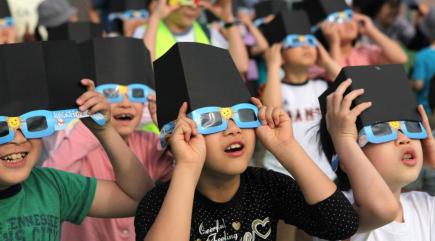Educator Onboarding
LEO Art Challenge Workshop
ICE 2019: Satellite Tracking, Orbits, and Modeling
SEEC 2019: Satellite Tracking, Orbits, and Modeling
Workshop:ITEC Trek-a-Sat
Workshop: 2018-01-27 Yerkes
Workshop: 2017-10-28 Carthage-Yerkes Electrostatics in Space
Workshop: 2017-06-29-BTCI-Life in Space!
Workshop: 2017-03-11 Yerkes
Workshop: 2017-02-07 SEEC
Workshop: 2017-01-28 Yerkes
Tools You Might Use
Educational Learning
Standards
Documentation
Solar Eclipses (K-2)
Topic outline
-
Author: Kimberly Tran Updated August 2023
Grade levels: K-2
Subject areas: Astronomy, Math, solar eclipse, sun, moon, stars, orbit, shadow, solar viewers
NGSS: 1-ESS1-1. Use observations of the sun, moon, and stars to describe patterns that can be predicted.
Summary: In this lesson, students will learn about solar eclipses and participate in a fun activity to build eclipse glasses (also known as solar viewers) that will allow them to directly view solar eclipses.-
Here educators can share pictures and links, along with discuss anything related to solar eclipses
-
This website provides teaching material and a gallery on solar eclipses
-
This website features an eclipse countdown along with various workshops around the United States of America
-
-
Light travels in straight lines, which is how shadows are made. If you stand in front of the sun outside, you can see your shadow in the sidewalk. Can things in space make shadows like that? In fact, there's a special word for when things in space cast a shadow on the Earth. This is called an eclipse. Today we'll be talking about solar eclipses.
The Earth orbits (or moves) around the sun, and the moon orbits around the Earth. A solar eclipse is what happens when the moon covers the sun, which then casts a shadow on the earth. This can happen once every 18 months and lasts for a few minutes.
This video by SciShow Kids talks about how solar eclipses happen.
**NOTE** This video discusses solar eclipses that will be occurring in 2015 and not in the future. -
It is very important that you don't look at a solar eclipse with unprotected eyes. The Sun's rays are very harmful to your eyes even if it is being blocked by the moon. To safely see a solar eclipse, you can get special glasses that will help you see the sun. Another way to view a solar eclipse is using a pinhole projector which you can make with an adult.
This video by EyeSmart talks about how to safely see a solar eclipse.

In this picture, a group of students are using solar eclipse viewers to see a solar eclipse.
(via bt.com)-
This is one website where you can buy solar eclipse glasses.
Note- There are other websites that provide solar eclipse glasses. Feel free to recommend them in the forum.
-
-
The following video explains how to make a pinhole projector. Be sure to have an adult around to help with the construction of the projector.
This video by NUSlife goes over how to make a pinhole projector
For written instructions please click on the link below: https://www.timeanddate.com/eclipse/box-pinhole-projector.html
This is one example of what your pinhole projector might look like when it is complete.
-
-
Please take the time to complete this survey so we may continue to improve this course for present and future students
-
-
Send a Postcard to Space through NSS Supported Blue Origin Club For The Future initiative!
Visit: SpacEdge Academy Postcards in Space Course

